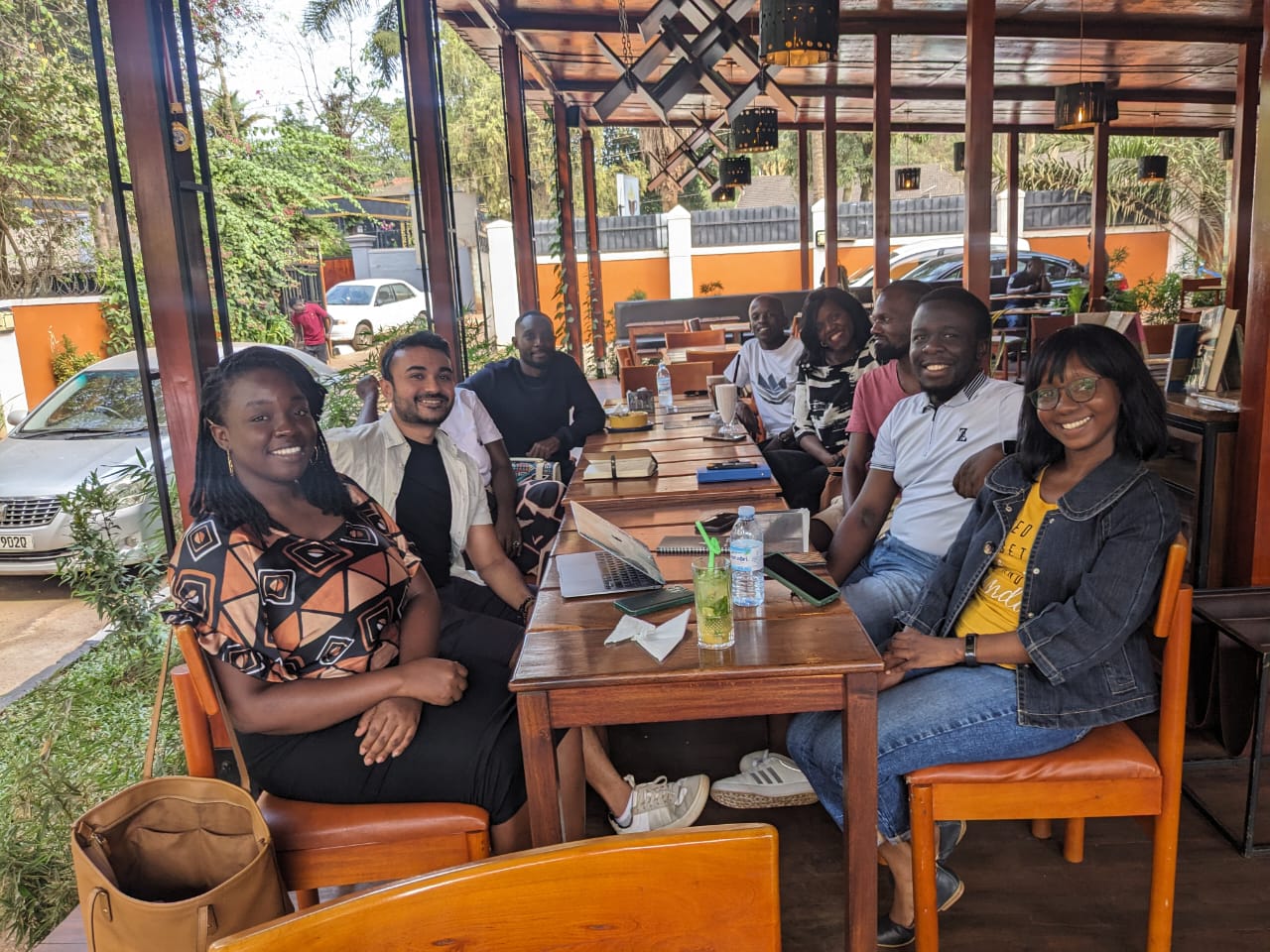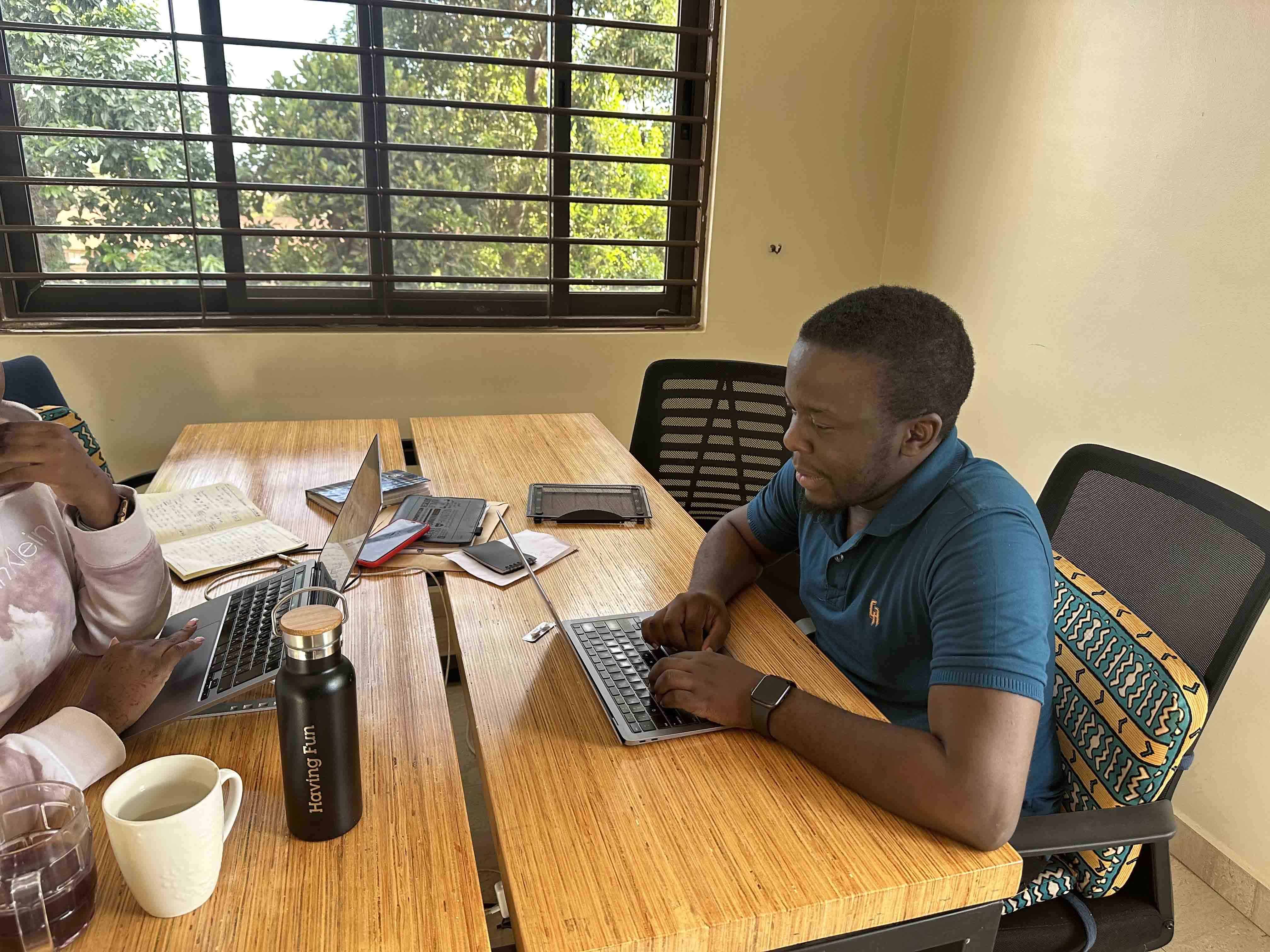Welcome to our interactive blogpost featuring an interview with Steven, a talented UI/UX designer working at Numida with five years of experience.
Originally from Kenya but now calls Uganda home, Steven alongside Michael, Henry, Pol, Frank are the co-founders of the vibrant Kampala Design Community, where creative minds in Uganda gather to collaborate, innovate, and drive the design industry in Uganda forward.

Sasha (left) and Rajay (behind Sasha) from YUX interacting with Steve (2nd on the right) and other members of the Kampala Design Community during a field trip to Uganda.
During a field trip to Uganda, our Lead UX researcher, Sasha, engaged in an interview with Steven, a seasoned design professional. They discussed his journey into design, the challenges he's faced, and his views on the evolving landscape of UX and UI design in Africa.
Collectively, this interview sets the stage for an exciting upcoming study on the State of UX Research 2023, promising to be a resource for professionals seeking to understand the evolving user experience landscape in Africa. (read previous studies from 2021, 2022 here)
Eager to learn more about his journey and how it applies to you? Come along as we dissect the highlights of our conversation in this article below.
Steven’s Journey into the world of Design
Sasha: Steven, could you tell us about your background and what sparked your interest in UI/UX design?
Steven: I have a background in Mechatronic engineering. However, I was always interested in graphic design, which led me to explore areas like designing business cards and logos. Eventually, I transitioned into product design. My passion for UI/UX design emerged from the desire to create meaningful and user-friendly experiences.
Sasha: What has Paved the Way for Your UI/UX Design Journey, and How Has Mentorship Shaped Your Career
Steven: Especially in the field of UI/UX design, mentorship is invaluable. When I started, I lacked a mentor, and I felt the need for someone to guide me. While I currently don't have a designated design manager at Numida, I do have a manager who understands my role and how to bring the best out of me. Having a mentor or someone experienced to learn from is crucial, but in Africa, mentorship can be challenging to find. Resources and materials were scarce in the past, but now there are more available.
UX/UI Design in the African Tech World
Sasha: You mentioned working in both Kenya and Uganda. In your opinion, how do these two countries differ in their approach to technology?
Steven: In terms of tech perception Uganda differs from Kenya. In Kenya, technology is more easily adopted, and there are more UX jobs available due to exposure to tech companies and favorable policies. In Uganda, the tech scene is still evolving, with limited innovation, and even some platforms like Facebook are blocked. To thrive in the Ugandan tech scene, there's a need for a shift in how the country perceives technology and policies supporting it.
Sasha: Can you share some of the methods you used to educate yourself and others in the early stages of your career?
Steven: Back when I began my career, resources were limited. I relied on articles, YouTube videos and newsletters to kickstart my design journey. Now, there are more resources available, including institutions like Moringa in Kenya and Refactory in Uganda for upcoming designers. The main barrier is the cost, but with time, I believe more design institutions will spring up and this will improve accessibility to design education.
Sasha: How do you see the role of UX in helping African businesses evolving?
Steven: The future of UX in Africa depends on whether companies prioritize UX. Some companies entrust UX responsibilities to graphic designers, which can be seen as a rather imprudent practice. But thankfully times are changing now and It's essential to recognize the distinct value that UX professionals bring to the table. Prioritizing UX as an integral part of the business can foster better user experiences.
A Day in the Life of an African UI/UX Designer

Steven in full work mode in the Numida office
Sasha: Can you tell me what a typical day looks like for you at Numida?
Steven: My day involves a mix of tasks. It may involve checking in on clients(internal or external) and addressing their issues. We test and fix the product to resolve client concerns or introduce new features. Collaboration is key – I work closely with project managers, developers, and fellow designers. We brainstorm, create wireframes, and proceed to UI design. Multiple rounds of testing ensure the product aligns with user expectations. Stakeholder meetings are also essential to gather their problems, feedback and manage their expectations on projects. As we evaluate the outcomes of our collective work thus far, we specifically highlight the contributions we’ve made that have had a meaningful impact on user experience.
Sasha: What challenges do you face in your role as a designer?
Steven: Particularly in terms of effectively conveying our accomplishments and persuading stakeholders to embrace the user's perspective, which is supported by the data? I believe this is my primary hurdle.
Sasha: How do you communicate this challenge to stakeholders and help them understand it from the user's point of view?
Steven: I address it by presenting data to the stakeholders and emphasizing that adopting an alternative approach which they’ve proposed will not yield valid results, as we heavily rely on data to make informed decisions and validate our design choices.
Research Methods in Africa
Sasha: Have there been instances where research results were utilized in product development?
Steven: Yes, there have been such instances. One that comes to mind is a certain work around our referral program. We wanted to change the way in which our clients were sharing the app, because previous methods were not working. We had two possible ideas that we were then able to run through an A/B test. One version showed a better success rate compared to the other and that is how it was chosen for a full rollout.
Sasha: Interesting! What other research methods do you employ apart from the methodology you've mentioned?
Steven: We look at what works best for us and what has failed historically. We also use the usability testing methodology, in-depth interviews, market research, just to mention a few. We realized surveys didn’t work for us in our context and weren't helpful and so we hardly use them for our internal clients.
Sasha: Can you elaborate on the reasons behind this decision in relation to participant behavior regarding surveys?
Steven: The sincerity of their responses and their effectiveness were the issues, the answers received didn't yield the quality. Sometimes the users just fill the survey for the incentives and we get multiple answers from the same person always. We discovered that talking to participants directly and observing their actions was more effective in producing quality insights compared to simply sending them surveys to fill out.
Sasha: Based on your experiences, what are the most effective approaches to conducting research in Africa?
Steven: Knowing who the users to engage with is crucial. Engaging with users and incorporating a variety of research methods is essential. Relying on a single method is inadequate, consider using techniques like triangulation(relying on multiple data sources). Additionally, it's valuable to interact with clients, gain insights into their businesses, understand their pain points, and directly observe their experiences. It's worth noting that in Africa, clients tend not to use tools extensively, and practices like card sorting are not prevalent. Hence, the traditional approach of conducting research by going to the field. fieldwork remains the primary method of choice.
Sasha: We all know that as Africans we are very diverse and speak multiple languages. Tell me how do you go about tackling the hurdles that come with dealing with local dialects and how do you prepare your team before going to the field and working with locals?
Steven: Well, my approach involves partnering with someone who is fluent in the local language. However, it's crucial that we also provide them with coaching to ensure they fully grasp the objectives of our project.
Before heading to the field, I typically bring along a product analyst, as they possess an understanding of the issues we're addressing. I then coach them on the specific questions to ask, how to pose them, and the follow-up questions to use.
Sasha: Has this approach been effective so far in your experience?
Steven: Yes, it has consistently proven effective. Not only does it lead to successful research outcomes, but it also gives our team the opportunity to enhance their comprehension of how user experience (UX) functions in product development.
Sasha: What research methods do you find most effective in the African context?
Steven: Usability testing is a valuable method and very effective, as we get to see with the users how they use the products and their pains while using the product. Conducting in-depth interviews is an effective methodology too as you can obtain sincere and effective answers from users. Observation and understanding the nuances of African users' behavior are key.
Sasha: Can you share best practices for conducting research in the African context ?
Steven: First is knowing who to talk to, that is your users and target audience is very important then picking research methods that suit the needs of that moment. Also having a Stakeholders interview to understand their pain points, and understanding the business is very crucial. Relying on trends and data is also key.
On the Rise of AI in UX
Sasha: How do you feel about AI's impact on UX and UI design? Are you worried it might replace jobs in our field, as some claim?
Steven: Some designers and artists might be concerned about the availability of apps that can quickly reproduce existing designs or images. However, when it comes to UX research, the impact is relatively limited. There are actually many opportunities for designers in the AI world. But it's important to recognize that AI still struggles to understand the nuances of the African context. While AI can handle UI design, it's clear that the intricacies of the UX research process remain beyond its capabilities.
Sasha: How do you think UX/UI professionals can position themselves for the changing times, especially with the rise of AI?
Steven: Continual learning and staying updated with industry changes are essential. AI may take over some tasks but can also create new opportunities. Adaptation is key.
Sasha: Do you use AI in your workflow?
Steven: Oh yes! I do! I use ChatGPT and have tested the Microsoft AI but did not use it in my workflow. It's crucial to explore and understand how AI can complement your work.
Conclusion
Steven's journey from engineering to UX demonstrates that educational background is not a barrier to entering the UX field. Just like him, you can embrace strategic mentorship, join UX communities, continually learn through articles and resources, and stay updated with the evolving tech landscape to shape a successful career in UI/UX design
As we continue to map out the UX space in Africa, we invite you to fill our survey to help us bring more value through data-driven decisions. Filling the survey allows us to learn more about the tools, methods, salaries, and challenges UX professionals are facing in the field. Your input is invaluable in shaping the future of UX in Africa."
Fill our survey here :
https://survey.getlooka.com/crowdsourcing/onboarding/-NgP7bK2cNLIYbqBgktd
Eager to connect with Steven?
Interview written by Sasha and Azeezah and summary created with the help of chatGPT



